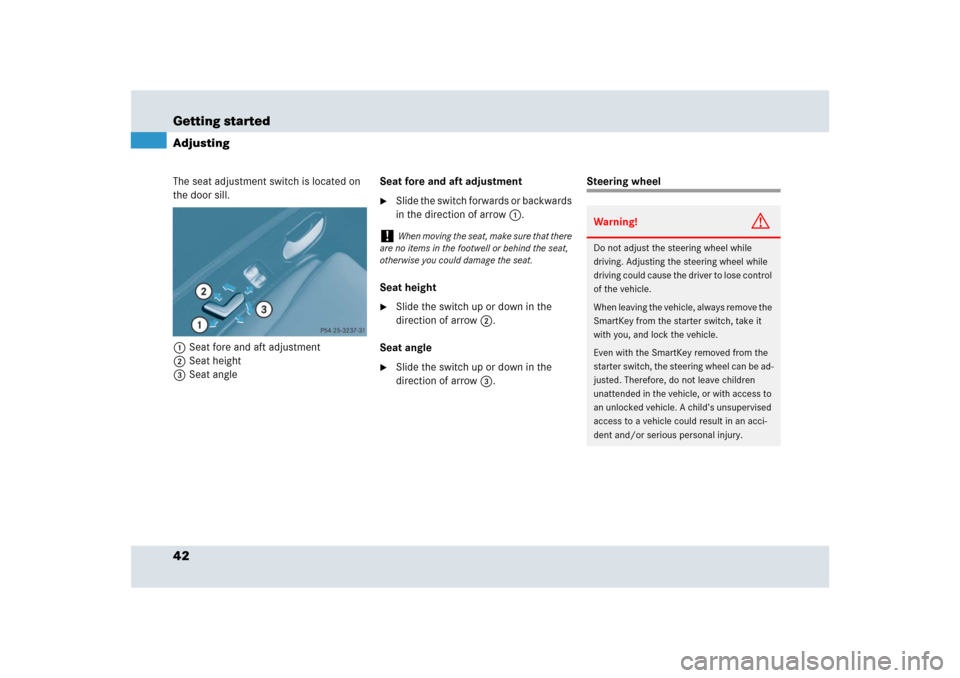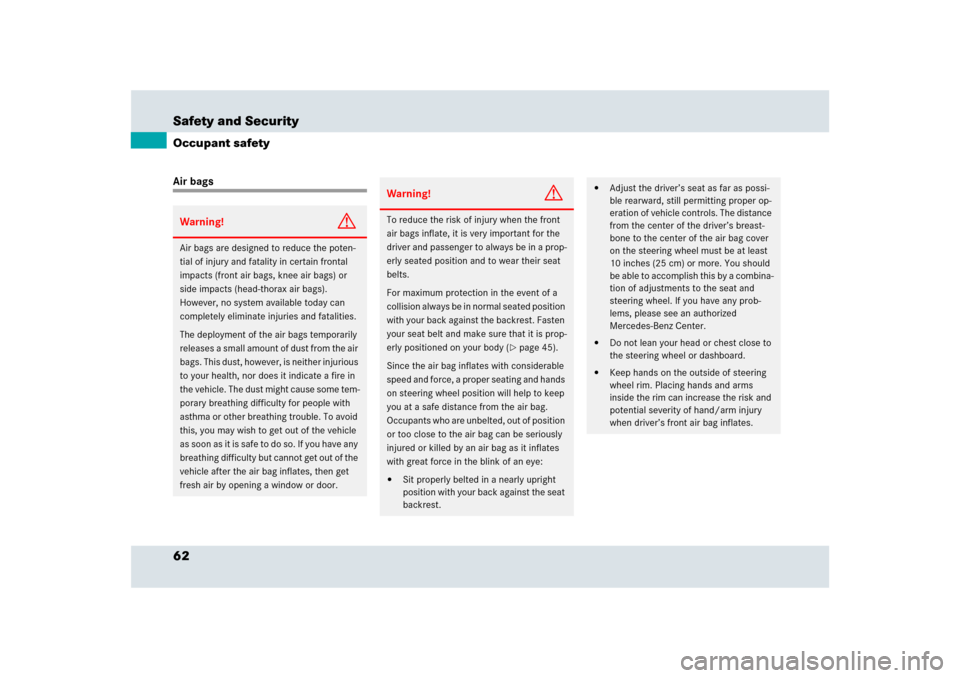Page 41 of 426

41 Getting started
Adjusting
�Adjusting
SeatsWarning!
G
All seat, steering wheel, and rear view mirror
adjustments, as well as fastening of seat
belts, must be done before the vehicle is put
into motion.Warning!
G
Do not adjust the driver’s seat while driving.
Adjusting the seat while driving could cause
the driver to lose control of the vehicle.
Never ride in a moving vehicle with the seat
back in an excessively reclined position as
this can be dangerous. You could slide un-
der the seat belt in a collision. If you slide
under it, the seat belt would apply force at
the abdomen or neck. That could cause se-
rious or fatal injuries. The seat back and seat
belts provide the best restraint when the
wearer is in a nearly upright position and
seat belts are properly positioned on the
body.Warning!
G
Your seat must be adjusted so that you can
correctly fasten your seat belt (
�page 45).
Observe the following points:
�
Adjust the seat to a comfortable seating
position that still allows you to reach the
accelerator/brake pedal safely. The po-
s i ti on s ho ul d be as fa r t o t he r ea r a s po s -
sible, consistent with ability to properly
operate controls.
�
Adjust the seat until a comfortable
steering wheel position is reached with
your arms slightly bent at the elbow.
�
Never place hands under the seat or
near any moving parts while a seat is
being adjusted.
Failure to do so could result in an accident
and/or serious personal injury.
Warning!
G
When leaving the vehicle, always remove the
SmartKey from the starter switch, take it
with you, and lock the vehicle.
Even with the SmartKey removed from the
starter switch, the seats can be operated.
Therefore, do not leave children unattended
in the vehicle, or with access to an unlocked
vehicle. A child’s unsupervised access to a
vehicle could result in an accident and/or
serious personal injury.
Page 42 of 426

42 Getting startedAdjustingThe seat adjustment switch is located on
the door sill.
1Seat fore and aft adjustment
2Seat height
3Seat angleSeat fore and aft adjustment
�
Slide the switch forwards or backwards
in the direction of arrow 1.
Seat height
�
Slide the switch up or down in the
direction of arrow 2.
Seat angle
�
Slide the switch up or down in the
direction of arrow 3.
Steering wheel
!
When moving the seat, make sure that there
are no items in the footwell or behind the seat,
otherwise you could damage the seat.
Warning!
G
Do not adjust the steering wheel while
driving. Adjusting the steering wheel while
driving could cause the driver to lose control
of the vehicle.
When leaving the vehicle, always remove the
SmartKey from the starter switch, take it
with you, and lock the vehicle.
Even with the SmartKey removed from the
starter switch, the steering wheel can be ad-
justed. Therefore, do not leave children
unattended in the vehicle, or with access to
an unlocked vehicle. A child’s unsupervised
access to a vehicle could result in an acci-
dent and/or serious personal injury.
Page 62 of 426

62 Safety and SecurityOccupant safetyAir bagsWarning!
G
Air bags are designed to reduce the poten-
tial of injury and fatality in certain frontal
impacts (front air bags, knee air bags) or
side impacts (head-thorax air bags).
However, no system available today can
completely eliminate injuries and fatalities.
The deployment of the air bags temporarily
releases a small amount of dust from the air
bags. This dust, however, is neither injurious
to your health, nor does it indicate a fire in
the vehicle. The dust might cause some tem-
porary breathing difficulty for people with
asthma or other breathing trouble. To avoid
this, you may wish to get out of the vehicle
as soon as it is safe to do so. If you have any
breathing difficulty but cannot get out of the
vehicle after the air bag inflates, then get
fresh air by opening a window or door.
Warning!
G
To reduce the risk of injury when the front
air bags inflate, it is very important for the
driver and passenger to always be in a prop-
erly seated position and to wear their seat
belts.
For maximum protection in the event of a
collision always be in normal seated position
with your back against the backrest. Fasten
your seat belt and make sure that it is prop-
erly positioned on your body (
�page 45).
Since the air bag inflates with considerable
speed and force, a proper seating and hands
on steering wheel position will help to keep
you at a safe distance from the air bag.
Occupants who are unbelted, out of position
or too close to the air bag can be seriously
injured or killed by an air bag as it inflates
with great force in the blink of an eye:
�
Sit properly belted in a nearly upright
position with your back against the seat
backrest.
�
Adjust the driver’s seat as far as possi-
ble rearward, still permitting proper op-
eration of vehicle controls. The distance
from the center of the driver’s breast-
bone to the center of the air bag cover
on the steering wheel must be at least
10 inches (25 cm) or more. You should
be able to accomplish this by a combina-
tion of adjustments to the seat and
steering wheel. If you have any prob-
lems, please see an authorized
Mercedes-Benz Center.
�
Do not lean your head or chest close to
the steering wheel or dashboard.
�
Keep hands on the outside of steering
wheel rim. Placing hands and arms
inside the rim can increase the risk and
potential severity of hand/arm injury
when driver’s front air bag inflates.